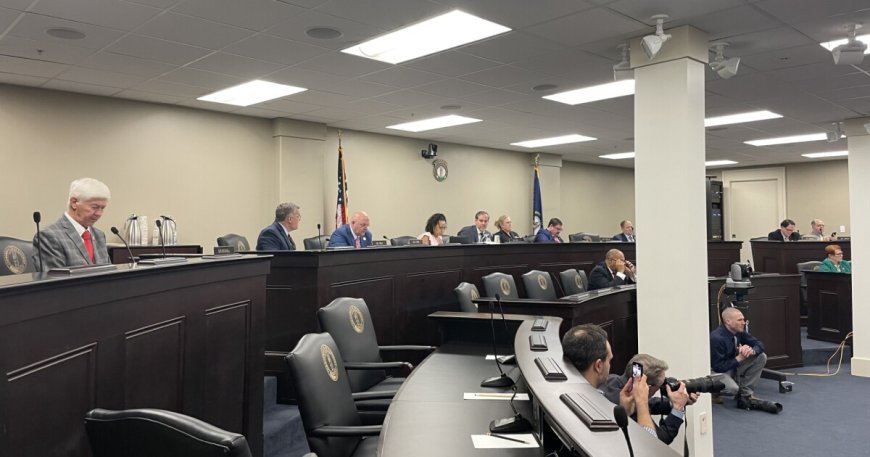Kentucky Senate panel rejects House-approved child labor law changes
Kentucky Senate panel rejects House-approved child labor law changes WEKU

A Kentucky Senate Committee Rejects Proposed Changes to Child Labor Law

A Kentucky Senate committee has rejected legislation aimed at modifying Kentucky’s child labor law. The measure would open the door to 16-and 17-year-olds working many more hours outside of school. Committee Chair Max Wise indicated the already House-approved bill could be taken up again in a special meeting. GOP Bill Sponsor Phillip Pratt believes laws are unintentionally being broken because state wage and hour laws are confusing.
Confusion Surrounding Child Labor Laws in Kentucky
- 14-15 year olds follow federal regulations
- 16-17 year olds face more restrictions
- Small businesses struggle with compliance due to confusing state laws
“14-15 year olds, we follow the federal word for word. 16-17 year olds they start getting more restrictive, so again we’re just trying to keep small businesses who don’t have the resources of large businesses out of trouble with the Kentucky Wage and Hour Law,” said Pratt.
Opposition to the Proposed Changes
Speaking in opposition was Dustin Pugel (PEW-gel) with the Kentucky Center for Economic Policy. He said under the bill, the current school and work hour cap of 75 hours would be removed. On work safety issues, Pugel told committee members in some instances the bill takes Kentucky protections below federal law.
“While we are grateful to the sponsor for making changes to ensure that Kentucky kids are not working overnight, we remain deeply concerned about the impacts that removing state protections on daily and weekly hours worked and going below the federal standards on allowable occupations would have on job safety,” said Pugel.
Pugel said the bill language on apprenticeships would allow 16 and 17-year-olds to work jobs in coal mining and logging as well as other higher-risk jobs.
Support for the Proposed Changes
Pratt said the bill allows these teens to gain valuable work experience. He said the state can’t trump federal law when it comes to safety protections.
Sustainable Development Goals (SDGs)
- No Poverty
- Decent Work and Economic Growth
- Reduced Inequalities
- Sustainable Cities and Communities
- Responsible Consumption and Production
* WEKU is working hard to be a leading source for public service, and fact-based journalism. Monthly supporters are the top funding source for this growing nonprofit news organization. Please join others in your community who support WEKU by making your donation.
SDGs, Targets, and Indicators
| SDGs | Targets | Indicators |
|---|---|---|
SDG 8: Decent Work and Economic Growth |
|
|
SDG 4: Quality Education |
|
|
Analysis
1. Which SDGs are addressed or connected to the issues highlighted in the article?
The issues highlighted in the article are connected to SDG 8: Decent Work and Economic Growth and SDG 4: Quality Education.
2. What specific targets under those SDGs can be identified based on the article’s content?
Based on the article’s content, the specific target under SDG 8 that can be identified is Target 8.7: Take immediate and effective measures to eradicate forced labor, end modern slavery and human trafficking, and secure the prohibition and elimination of the worst forms of child labor. The article discusses the proposed modification of Kentucky’s child labor law, which could potentially affect the protection of minors from exploitative work conditions.
Under SDG 4, no specific targets can be identified based on the article’s content.
3. Are there any indicators mentioned or implied in the article that can be used to measure progress towards the identified targets?
No specific indicators are mentioned or implied in the article that can be used to measure progress towards the identified targets.
Overall, the article provides limited information regarding indicators or measurable progress towards the identified targets.
Behold! This splendid article springs forth from the wellspring of knowledge, shaped by a wondrous proprietary AI technology that delved into a vast ocean of data, illuminating the path towards the Sustainable Development Goals. Remember that all rights are reserved by SDG Investors LLC, empowering us to champion progress together.
Source: weku.org

Join us, as fellow seekers of change, on a transformative journey at https://sdgtalks.ai/welcome, where you can become a member and actively contribute to shaping a brighter future.







